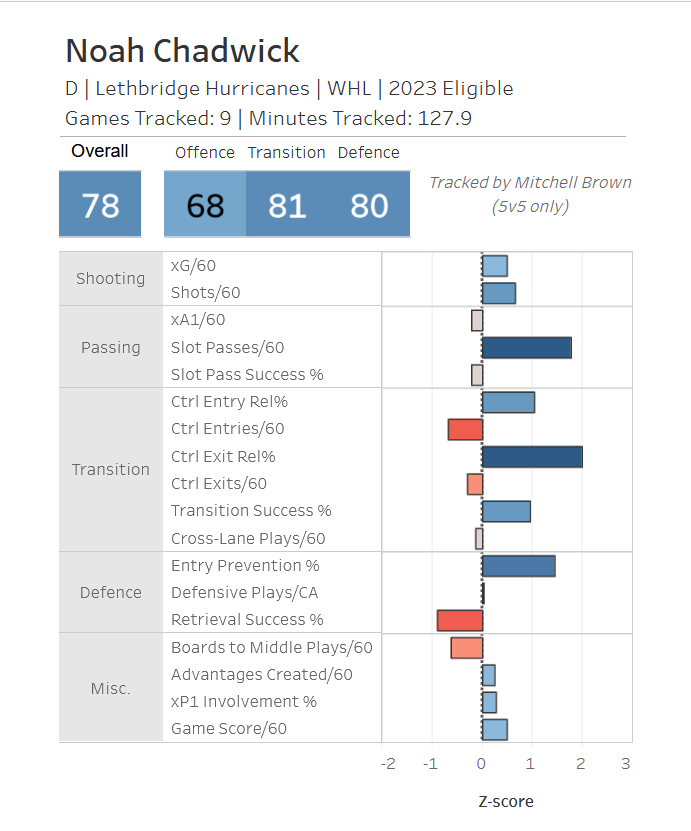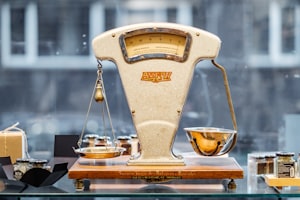When Noah Chadwick was selected by Toronto in the 6th round, he was immediately someone that seemed more interesting to me. First, because he was the first defenseman Toronto had drafted in three years. Second, because in a lot of ways he broke the mold for the kinds of prospects that the Leafs were thought to covet. Mainly, that he was big and not a great skater – because we all know Toronto only target small scoring forwards who zip all around the ice, right?
Except for Filip Kral, William Villeneuve, Matthew Knies, Fraser Minten and Nikita Grebyonkin. They don't count.
But the funniest thing happened when I dug into Chadwick and his history, watched some highlights, and watched him at their development camp scrimmage. I saw that they did draft a typical Maple Leafs-type prospect, who I assume is an otherkin as a small, smart, zippy forward stuck in the body of a hulking 6'4" defenseman.
So let's talk about who Chadwick is, and who he isn't.
THE BASICS: STATS AND CONTEXT
Position: LD
League: WHL
Height: 6’4”
Weight: 187 lbs
Birth date: May 10, 2005
Chadwick was drafted to the WHL 38th overall by the Lethbridge Hurricanes. At the time, he was listed as 6'0" and pretty thin at 150 lbs. Despite already being an average height for a hockey player, Chadwick would go through another growth spurt or two since then. In fact, he seems to have added two inches to his listed height between the start of this season (6'2") and the day he was drafted by Toronto (6'4"). But his weight has barely changed, making him still a really scrawny kid. We may have found our newest Giraffe.
At the time he was drafted into the WHL, Chadwick had a reputation for being a strong offensive defenseman. He had 42 points in 21 games in AA as a defenseman and captain, playing on the same team as fellow Toronto draft pick Hudson Malinoski. That was good for 6th in the league for all defenseman, but 2nd in the league based on points per game. Like all other prospects, Chadwick missed the next season because of the pandemic shutting leagues down. His next season he played in AAA, and finished tops in the league for defensemen with 45 points in 42 games. He earned a 13 game stint in the WHL, making his debut for Lethbridge to end the year and playing in 4 playoff games.
That brings us to this past season, which was Chadwick's first full year in the WHL. He only finished with 20 points in 67 games, which was just outside the top 50 in the entire WHL for points by an U18 defenseman. He also added one point in four playoff games after. That is a point production pace well below what he had done at every other level before this season, but there are some good points to consider.
First, Lethbridge were not a very good team offensively. They finished 6th worst in total goals for, despite being a top 10 team in the league standings. They had zero players on their team of any age or position who were a point per game or better. They weren't even that close – their top player had 55 points in 65 games. In some scouting reports for Chadwick, I could read some frustration that the team around him were not playing at a level to keep up with his playmaking.
Some of that is borne out by his tracking data:

Overall, Chadwick seemed to profile as a balanced defenseman who wasn't elite at any one thing. But reading the specifics of the chart is fascinating. Despite having an extremely high success rate for zone exits, entries and transition success, the per 60 rates were all very low. What that says to me is that while he was not relied on a lot to drive transitions for his team while on the ice, he was very good at it when he was. It's also odd to see him have a very high rate of success for exiting the zone, but having a low percentage of success retrieving dump ins.
I do know that Chadwick seemed to play on their second pair, but didn't get a lot of powerplay time for most of the year. They had two defensemen who both had 13+ powerplay points, then the rest of their regular defensemen all had 1 to 5 powerplay points. Chadwick was one of them to have 5. He seemed to be used more at even strength and on the penalty kill, where his size and reach likely helped a lot.
THE GOOD: DECISION MAKING, PLAYMAKING
I got the sense from reading his scouting reports and watching his clips or the scrimmage, that the reason why Toronto loved Chadwick is because of his decision making. We know they talk about how much they value players who are smart, and in Chadwick's case that comes out in the actions he decides to take (or not), including when and how to do certain things.
Chadwick just makes smart reads of the play and acts accordingly. In the scrimmage, he didn't make a wrong decision – not when he jumped into the play on a rush, not when he pinched to keep a possession alive, not when he stepped up on a puck carrier aggressively. He didn't get burned when he made those decisions, even if he was a slower skater than a lot of the players he faced (more on that below). That's one of the main reasons why he's survived in spite of his skating issues, by anticipating how a play would develop and using his other tools to still be able to influence the play.
I don't want to overstate this because all I've seen was one meaningless scrimmage game and highlight clips, where obviously he will look at his best. But I was very impressed by the scrimmage, and it reinforces what I read in scouting reports and saw in his highlights. I was worried about how he may look defensively given his skating issues, but in junior and at the scrimmage he looked more than capable. His size, reach, and defensive instincts make up for any other issues he may have – at least for now.
Noah Chadwick defense highlights — he's either #8 in red, or #41 in white
That said, right now Chadwick's offensive instincts shine more often. I think that may be because once he has the puck, his skating becomes less of an issue. Players have to come to him, and when confronted with defenders he shows a slick pair of hands to elude them. That gives him the time and space he needs to decide on what play to make.
Noah Chadwick puck handling highlights - he's in #8 in every clip
Chadwick with time and space can be a weapon. He's not going to be Morgan Rielly in his ability to distribute the puck, but I think he has the potential to be above average in the NHL. Being 6'4" he has good vision of the ice, and as mentioned above he has good instincts and awareness for how a play can develop.
But as an added bonus, Chadwick has an underrated shot. Not that he only has a big bomb of a slapshot – though he does have a pretty good one of those too – but he also has a good wrist shot that's quick, accurate, and has some power behind it too. What makes his shot better is where he takes his shots from. He has really good instincts for when to join a rush as one of the late trailers, and when to creep in from the point when there's open space in the slot.
Noah Chadwick shooting highlights — he's always in #8
THE FLAWS: SKATING
There's no way around it, Chadwick's biggest problem is his skating. Right now his speed and footwork is below average, but not terrible. He can make some slick moves that necessitate having some agility, and he can move around enough to jump into plays and defend on transitions at a pretty high level – though his reach helps compensate enough that he's still an above average defender in junior.
The concern is about how Chadwick would project to the NHL, or even just the AHL. Pro hockey has a history of eating up and spitting out big, poorly skating defensemen since they were no longer able to just hook and bearhug players trying to blitz by them.
The higher the levels that Chadwick advances his career, the harder it will be for him to survive just on instincts and size. And while he can be above average in junior, it's already something that holds him back from having a bigger impact. In the WHL and at the scrimmage, there were times where speedier players get enough space to just speed around him – and no amount of reach or instinct could get him close enough to them to be able to defend against it.
That's the bad news.
The good news is that at least some of Chadwick's skating issues likely comes back to his late growth spurt and very scrawny frame. He doesn't have a lot of muscle to generate power from his strides, and he's likely still figuring out finer coordination in his legs. There are definitely some mechanics that he can improve and smooth out, and that's where Toronto's skating coaches will earn their salaries. There is a possibility that we can project his skating to be average at the NHL level as a result. There are enough elements that seem like more obvious and "easy" areas of improvement that will come just as a matter of time, practice and developing physically.
But being an average skater in the NHL would be the best he would likely be able to obtain. As I've said about William Villeneuve, who has dealt with this same issue, making a big improvement is good but that only goes so far when you're starting at a lower level.
OVERALL ASSESSMENT
So, the question is how far can we project Chadwick as a total package? Right now he showcases a high level of in-game instincts both offensively and defensively. He has an above average impact in every area of a hockey game in junior, but is held back by poor skating. He has good tools to compensate for now, in terms of size, skill and intelligence.
IF he can add weight and muscle and improve his skating mechanics enough that he becomes an average NHL skater, that would unlock so much more in his game. Just think of all the smart little plays he already makes, and the high level decision making he is already capable of. Adding more speed means he can cover more ground defensively and keep up with even higher level skaters thanks to his reach. Adding more agility means he won't get his feet tangled up by dekes, changes of movement or give and gos around him. Offensively, adding both means he can rush the puck more, jump into the play more, and create more separation.
That's the gamble with Chadwick, but he has enough interesting tools that it makes for a great late round swing. With average skating I think Chadwick could wind up being a second pair guy who may not get you out of your seats but does enough things well that you're not unsatisfied with him there. If he doesn't quite get to NHL average for his skating, or if the rest of his development does go as far as it could, he could still make it as a useful third pairing guy.
This season will be interesting for Chadwick. He seems likely to repeat as a second pair guy for Lethbridge, given that they seem to have all their defenders returning. But there is a chance he could earn more time on special teams, like on the penalty kill but also on the powerplay.






